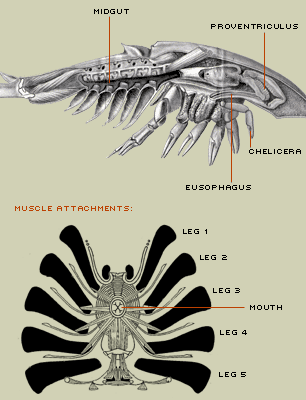How Does the Horseshoe Crab Eat?
Horseshoe crabs are the only chelicerates with a gut designed to handle solid food and so have a rather impressive digestive armament.
Limulus polyphemus belongs to a class called Merostomata, which means "legs attached to the mouth." Appropriately so, because the mouth of the horseshoe crab is in the center of its body, where the legs attach. It uses its hind legs to help break up food; the small front appendages, the chelicera, are primarily used to place food into its mouth.
The digestive tract begins with the bristly mouth and continues with a cuticle-lined esophagus. This turns backwards into the proventriculus, which is composed of a "crop" and a "gizzard." The crop can expand considerably to accommodate ingested food. The food then passes into the gizzard, which has the thickest muscular coat of the entire intestinal tract, where food is reduced to a pulp. Undigestible pieces, such as fish bones or large shell pieces, are regurgitated.
The pulverized food is then passed into the midgut, through the pyloric valve that protrudes from the end of the gizzard. There, it is digested. The hindgut, or rectum is a short muscular tube that opens through a slit-like anus at the base of the rectum.

Top illustration (modified) by A. Milne Edwards
Bottom illustration by Jeffrey Shultz